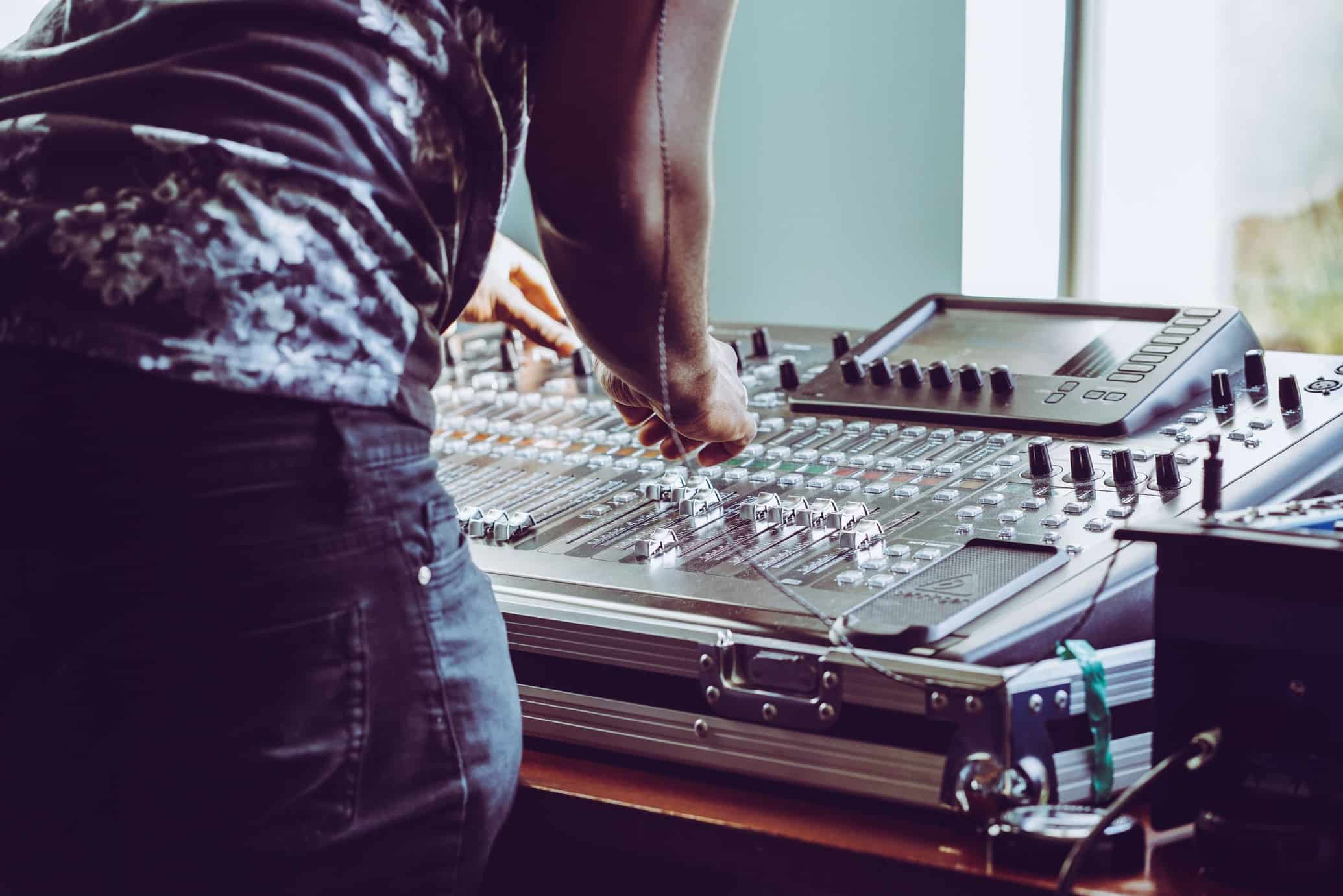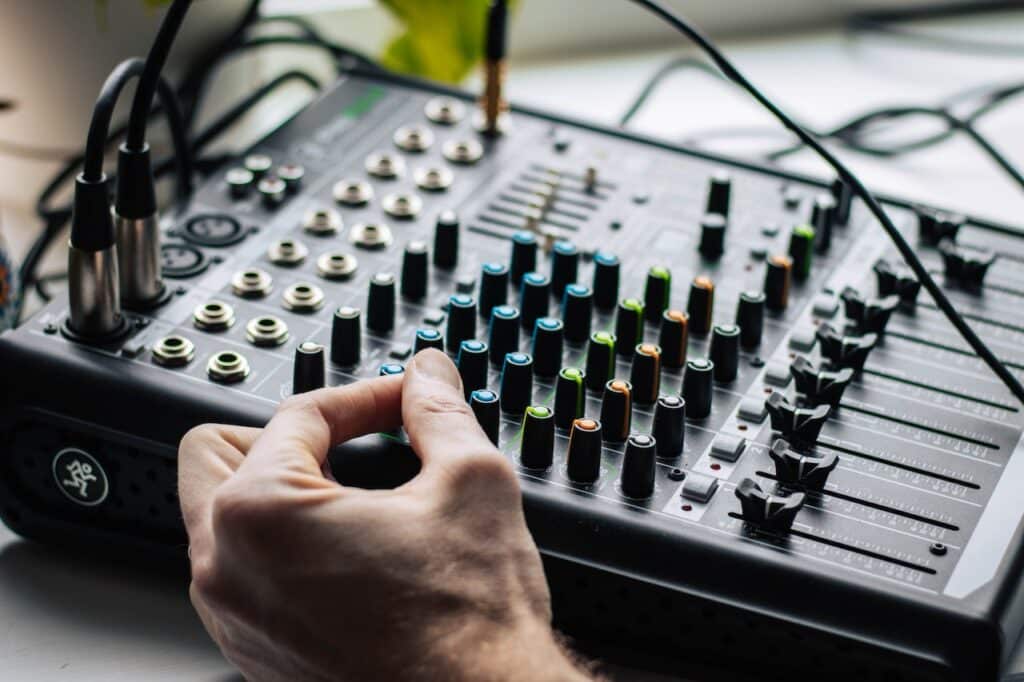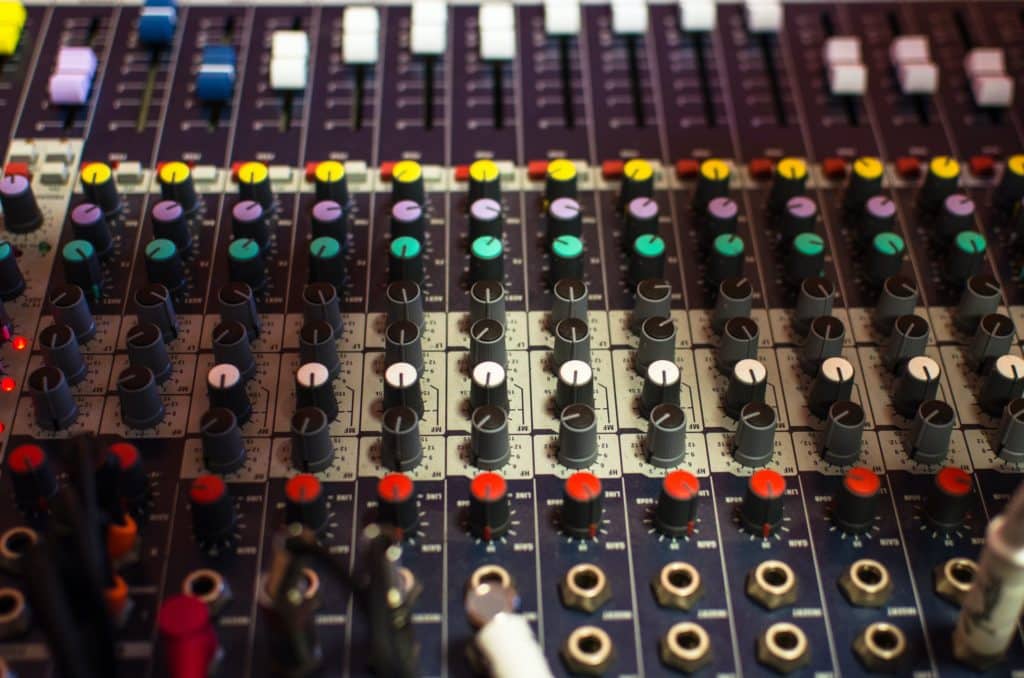Have you ever wondered what an audio mixer is and what it does? First-time users often ask this question. They might know about the equipment they need, but they are not exactly sure what an audio mixer does.
This post will cover everything about audio mixers, what they are, what they do, and how you can use them.
Stay with us till the end because plenty of info is coming your way.
What’s An Audio Mixer & What Does It Do?
An audio mixer is a device with the primary functions of accepting, combining, processing, and monitoring audio. Primarily, they have two main tasks Trusted Source Audio mixing - Wikipedia Audio mixing is the process by which multiple sounds are combined into one or more channels. In the process, a source’s volume level, frequency content, dynamics, and panoramic position are manipulated or enhanced. This practical, aesthetic, or otherwise creative treatment is done in order to produce a finished version that is appealing to listeners. en.wikipedia.org , and that is:
- Adjusting the volumes across different inputs.
- Shaping up the tone of the sound.
These different inputs must sound good together to make sure that the output sounds great to your audience at the event.
As we have mentioned, there are different inputs on a mixer. And other units come with different numbers and types of input options too.
For example, the Yamaha MG10 comes with 10 different units. Four out of these 10 are XLR inputs, and they are best for connecting XLR cable and mics.
While 3 out of these 10 inputs are stereo inputs that are good for all line-level inputs, these include computers, phones, keyboards, and similar other devices. Each of these stereo inputs has right and left channels, making 10 input channels.
Using Multiple Inputs Simultaneously
With 10 channels on this Yamaha audio mixer, you can conveniently plug in an iPod, mobile phone, or even a computer with four different mics simultaneously.
You can easily mix the volume using the audio mixer, and the output sounds balance well with your audience.
If you also have a speaker, you can turn down some specific frequencies to ensure your audience can listen while the music is on.
Feedback Control
Wireless lapel mics are extremely notorious because they cause feedback, particularly if you have more than two. If your speakers have these mics, you can easily use your mixer to eradicate these feedback frequencies causing the trouble.
How Are Audio Mixers Used?
Audio mixers are electronic devices that combine different sounds and audio signals from other devices. The purpose is to adjust them all to produce a much better sound for the audience to listen to.
The adjusted sound signals are sent to the output that can transmit and amplify the mix using the sound system.
Therefore, this mixer is a central hub that can receive sound signals from different sources and combine them.
You can also add effects and ambiance using the EQ and stereo imaging. From there, the output is directed to the monitor speakers with the help of the mixer.
Types of Sound Mixers
There are four different types of sound mixers, including analog, digital, software, and powered mixers. Each of these types has its pros and cons. Therefore, these units are suitable for different situations and scenarios.
Analog Mixers
When you generally have a mixing desk, the picture that comes to your mind is an analog mixer. It has a pretty standard appearance and a unified layout. Therefore, anyone who knows how to use a mixer will get along pretty well.
These devices run on analog electronics and have a single control per function. All these controls are visible and easily accessible on the control panel too.
You can immediately see what is going on in the audio mixer. So, you can quickly make adjustments whenever necessary. These mixers are perfect for live performances as well as recording.
As for the cost, these units are less expensive than their digital counterparts. But they also lack some sort of automation to fulfill specific setups.
Moreover, most of them don’t have wireless connectivity for remote access. It means you have to use the boards directly with your hands.
Moreover, these units have fewer onboard available effects than their digital counterparts. Therefore, if you want to go for more advanced audio effects, you will have to purchase more external hardware.
Pros
- Analog mixers are cheap to buy.
- They are pretty user-friendly, and there is not much difference between one unit and the other.
- Correcting any issues on them is pretty straightforward. All the controls are straightforward to see and access.
- You can conveniently set up your live mix and work on them according to your needs.
Cons
- These mixers can be pretty bulky in size based on the number of channels. So carrying their songs can be somewhat of an issue.
- The audio processing features and effects on these devices are pretty limited.
- They don’t have any wireless connectivity features, so you will have to deal with plenty of cables and wires.
- You don’t have any special features to use that allow you to recall or even reprogram any of your past gigs. So, each time you use your mixer, you will have to create new mixes.
Digital Mixers
Digital mixers have a much wider range compared to their analog counterparts. You can also recall and reprogram your previously created tunes using the controls.
It is a convenient feature that puts digital mixers way ahead of their analog counterparts. It comes in handy, especially if you want to set up something fast right in the middle of an event.
Most of the digital units come with wireless connectivity. You can easily connect them with your smartphone or computer and remotely control your mixer.
So, you don’t have to have potions right in front of your mixer when using it with the help of this remote access.
You can conveniently walk throughout the room as you are mixing your tunes. And with the connectivity feature, you will be sure your creation is heard everywhere in the room.
Digital mixers make it possible to have more controls on board and have more effects on each channel. Therefore, you won’t have to purchase any equipment separately to get better sound effects or better signal processing capabilities.
In most cases, you will get upgraded effects in signal processing capabilities by directly downloading the manufacturers’ updates. But making any adjustments using your digital mixer is a much more difficult process than using an analog mixer.
This is especially the case if you don’t have much experience under your belt using these mixers. And if you are looking to make more than one change in one go, you have to reprogram all the changes to much faster access. This is something pretty inconvenient using a digital mixer.
Pros
- You can easily pre-program and recall settings when you need them and don’t have to set up the mixer from the beginning.
- It can also accommodate more sound sources and effects as they are much smaller than their analog counterparts.
- Signals that digital sound mixers have processed are resistant to picking any line noise.
- Digital mixers can perform different tasks as each control has several features, and you can use them for different purposes.
- You can also use them to perform multitrack recordings.
- These units are pretty compact and portable. So, storage and transportation are pretty convenient.
Cons
- These units are pretty expensive compared to their analog counterparts.
- These units are pretty difficult to operate, and you need to have a special skill set to use these mixers, so you will get used to them only with time.
Software Mixers
Software misers are pretty easy to use because they come as software programs that you can install on your computer, and so all the mining by just connecting your devices to your computer or laptop.
By running this software on your computer, you’re essentially turning your computer into a mixer and using it to create your tunes. These software programs come with many features of digital mixers, and you can use them to create high-quality sounds pretty conveniently.
You will have all the benefits of using a digital mixer. But if you want to use an analog mixer, you can go for that particular software type. So, possibilities are endless here.
The best part is that this mixer type is pretty easy to store and transport because it is just the size and weight of your laptop or computer. Of course, storage and portability are much better with a laptop. Therefore, using these software mixers is pretty convenient.
Pros
- These software mixers come with a pretty versatile design. You can either choose to go for analog or digital types.
- You also have the option of going for hybrids that have both features of analog and digital units.
- As these software programs are on your computer or laptop, you don’t need separate spaces to store or carry them. They are just part of your laptop or computer.
Cons
- These software programs don’t come cheap if you look for the best performing types.
- You might have to spend a considerable amount of time understanding these programs first and then using them.
Powered Mixers
Yet another type of mixer is a powered mixer. These units are analog mixers, but they come with inbuilt amplifiers. Most of these powered mixers come with 2-amp channels, and you can plug in with one or more speakers and a monitor.
These units are pretty easy to set up and use, and they are also pretty compact, so they are pretty convenient to store and transport. Powered mixers also feature line-level outputs, enabling you to add more speakers and monitors.
Pros
- These units are pretty easy to set up and operate.
- These Units are also pretty compact and are portable when it comes to transportation.
- Powered mixers are best for their all-in-one integration.
Cons
- If a single part of this unit fails, you will have to replace the entire unit.
- You don’t have much variety in the features and sound effects.
 Choosing the Right Audio Mixer Based on Your Needs
Choosing the Right Audio Mixer Based on Your Needs
You have to consider various other factors when buying these audio mixers. There are different types of mixers available on the market. You have to keep in mind some important things when buying an audio mixer.
Price
Different models of audio mixers come at different prices. If you’re looking for a budget option, consider an analog mixer because it comes with a smaller price tag. But if budget is not your concern, you should consider going for a digital mixer.
The way between these two extremes is powered mixers and software mixers. So, you need to decide based on how many features you need in your mixers and how much you can afford.
User-Friendliness
Analog mixers are much easier to use compared to their digital counterparts. There are far fewer controls and customization options available in analog mixers. Moreover, signal processing is pretty simple.
This is because all inputs are directly related to the control. For example, if you connect your guitar to input 1 then the entire control panel in this channel will influence the guitar only.
But with digital mixers, you can pre-program and save and recall your settings. So, these digital units are a pretty important feature, and they work pretty well for larger events.
If you are a band and use the same music configuration for all your gigs, you will only have to set it up once and recall the configurations when you need them.
Sound Quality
Sound quality is another massive consideration when choosing the right type of audio mixer. The digital units are equal in quality with higher prices compared to the high-end analog units. However, at the bottom, you will notice that analog mixers are better than digital units in all aspects and sound quality.
Availability of Spare Parts
You also have to consider repair and maintenance issues. Therefore, considering everything, an analog unit about three decades old will be much easier to repair than a digital unit as its parts might still be available in the market today.
But the same cannot be said about digital units that are only 5 years old and spare parts if these units stop coming as soon as newer models start coming out from the brand.
And it also means that you will have to buy a new mixer at some point in the future. So, your digital unit will not last for more than a decade, no matter how hard you try.
Purpose
You have to identify what you will be using your mixer for. Maybe you need it for your live or stage performance, or you might use it for your home studio or recording.
You also need to look at the mic preamp and the mixer’s capability to handle any external hardware for live performances. Moreover, if you use it on the go, the unit must be robust in construction so it doesn’t fall apart or wear out between different uses.
Channels and I/O
You also need to think about how many mics you want to connect to your mixer. If you are using condenser mics, you need inputs with phantom power. If you use stereo instruments like keyboards, you need more stereo inputs.
Planning to connect your guitar directly to your mixer means it needs to house this input. So it is always better to have more channels and I/O options for your current and future needs to add more gear to your mixer setup.
EQ Requirements
When recording in a studio, you will have to fine-tune your sound and enhance the overall audio quality. Therefore, you will need multiband equalizers and filters to create excellent recordings. For this, a digital mixer is the best option.
On the other hand, if you like to do more simple sound mixes, you will need basic control over the highs, lows, and mids then an analog mixer is the top choice for you.
Sound Effects and Processors
If you heavily rely on sound effects and mic preamps along with other sound processing equipment for getting the best audio quality, then you might not need a separate unit that comes with its internal processors and sound effects.
But a mixer with internal sound effects and audio processing is a useful device. Moreover, it can be a portable and compact unit that you can use for live performances.
Signal Routing and Buses
You will need more signal paths and buses if you will be using a mixer for your larger events or when using multiple channel recordings. Therefore, you need to consider buying these options available within a unit if you want these options.
Otherwise, a primary signal routing option is suitable for your regular studio use if you are not an advanced user.
Conclusion
Audio mixers are devices that allow you to fine-tune the sounds from different sources and combine them into one. You can also add multiple effects to this sound.
There are different types of these audio mixers, and you have to pick one based on your needs and requirements. All these types of audio mixers have their positives and negatives.
Audio mixers allow you to expand your recording or mixing options. But you need to understand the pros and cons of each of these types and make the right choice based on your requirements.











